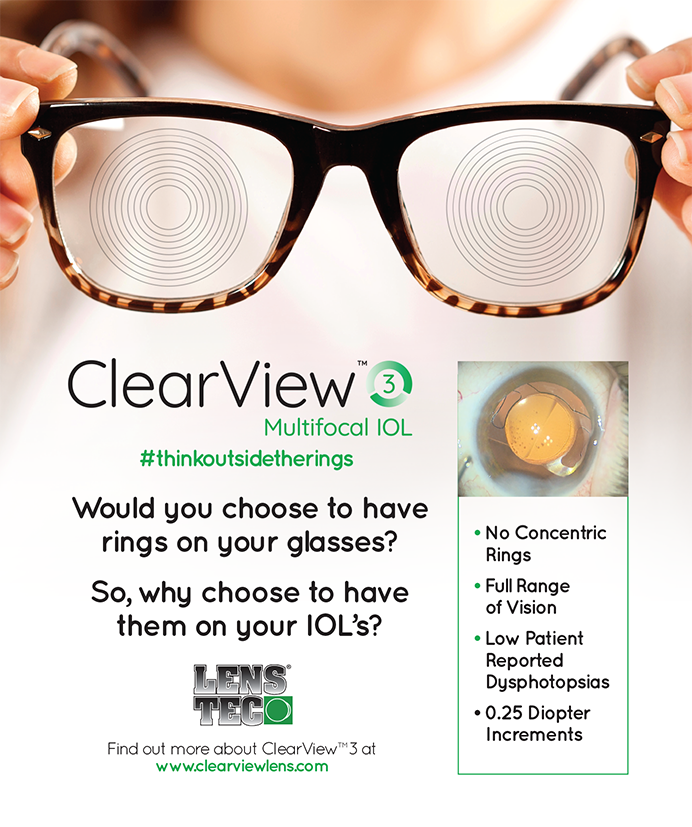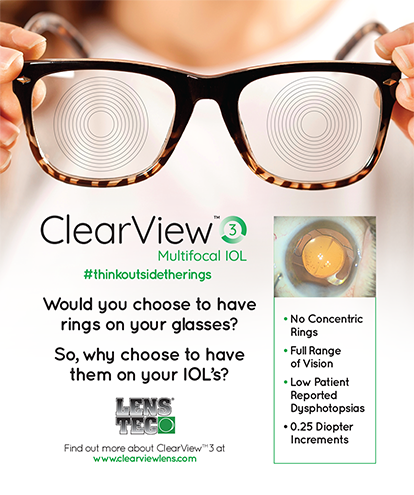Patients who present with an interest in refractive surgery are usually responding to the prevalent advertising for LASIK. Many are Baby Boomers with disposable income and a desire to rid themselves of glasses. Despite their interest in LASIK, many of these patients are not ideal candidates for the procedure, and that is an excellent reason for ophthalmic surgeons to offer the option of refractive lens exchange. Understanding which individuals are good candidates for the procedure will yield better outcomes and higher levels of patient satisfaction.
CONTRAINDICATIONSAccommodative Ability
Ideal candidates for refractive lens exchange are generally aged 45 years or older. Younger individuals can still accommodate. Refractive lens exchange will eliminate their natural multifocality and is usually an unacceptable option for this group.
Low Myopia
A patient with -2.00 to -3.00 D of myopia who has enjoyed excellent reading vision all his life is a poor candidate for refractive lens exchange with an Array lens (Advanced Medical Optics, Inc., Santa Ana, CA). Although the procedure can satisfactorily improve his distance vision, he will never be happy with his postoperative reading vision.
High Corneal Astigmatism
Limbal relaxing incisions are fairly reliable for correcting up to 2.00 D of astigmatism. Higher amounts of astigmatism will require an additional procedure such as LASIK after the refractive lens exchange. It is important that highly astigmatic patients understand this fact. In my experience, no matter what they say, patients expect the total correction of their refractive errors by one type of procedure. Documentation and the informed consent process are very important in this group.
Array-Specific Concerns
Picky patients are poor candidates for the Array lens, as are individuals who drive extensively at night and those who engage in intense near work, such as engineers. Good candidates for the Array are easygoing and desire reasonable reading vision. When screening patients, I first ask if they would like to see at both distance and near. Next, I inquire whether halos around lights at night will bother them. If patients become nervous when answering or begin questioning me further, I decide the lens is probably not for them and provide a brochure on the IOL that will thoroughly inform them of all the potential postoperative problems.
I also try to avoid implanting the Array lens in patients with small pupils, because they are unable to dilate enough to use the reading vision portion of this IOL. Additionally, it is important to ensure that patients plan to read at a normal distance. After I implanted the Array in a preacher, although he could read a book easily when holding it in my office, he was unable to read the Bible as it lay on the podium before him in church. Understanding patients' visual needs and expectations is paramount.
GOOD CANDIDATESMyopes
Unless they possess thick corneas and moderately sized pupils, patients with more than -8.00 D of myopia are often poor candidates for LASIK. They run the risk of iatrogenic keratoconus and, if undergoing significant myopic treatment, may experience serious problems with nighttime glare. These high myopes are often excellent candidates for refractive lens exchange, whereas low myopes generally are not good candidates unless they have early cataract formation. Many of the latter individuals are interested in refractive surgery because their visual acuity has worsened. Refractive lens exchange will both correct their myopia and remove their cataracts.
Hyperopes
Hyperopic patients aged older than 45 years who wish to eliminate their problems with reading vision are generally the best candidates for refractive lens exchange. One reason is that hyperopic LASIK is a good, but not great, procedure that produces varying levels of patient satisfaction. In my hands, LASIK does not work very well for patients requiring a correction of 5.00 D or more, and individuals with +3.00 D of hyperopia or higher are poor candidates for LASIK monovision for this reason.
Contact lens wearers who have had long-term success with monovision will likely enjoy refractive lens exchange for monovision. With the IOLMaster (Zeiss Humphrey Systems, Dublin, CA) and other contemporary methods of IOL power calculations, surgeons are able almost routinely to correct patients to 20/20 vision in one eye and excellent reading vision in the other, all without compromising their corneal integrity.
Hyperopes uninterested in monovision but wishing to eliminate their need for reading glasses will not be served by LASIK, which can only correct their distance vision. Refractive lens exchange with the Array (or another multifocal IOL in the future) will permit them to see well at distance while still enjoying reasonable reading vision. This option is attractive to a significant number of these individuals.
Plano Presbyopes
Patients without a refractive error who present with early cataract formation and a desire to be free of reading glasses are good candidates for refractive lens exchange with the Array or with monovision (if they have been successful with that modality in contact lenses).
Patients With Lenticular Astigmatism
Someone interested in refractive surgery who has lenticular, rather than corneal, astigmatism will achieve a better outcome with refractive lens exchange than LASIK. I performed LASIK on such a patient years ago, and his postoperative visual acuity was never of the caliber achieved by my other LASIK patients. Four years later, I treated a similar patient with refractive lens exchange. He has excellent postoperative vision and has never presented with a complaint.
MONOVISION
I believe that performing monovision necessitates consideration of the Tecnis lens for implantation, because this IOL provides patients with excellent contrast sensitivity in their distance-vision eye (Figure 1). Its use is less important in the eye corrected for near vision, but I use the IOL bilaterally.
I have found that trials with contact lenses are less successful than simply performing the procedure and allowing the brain to adapt. Even so, I always encourage patients to undergo a contact lens trial if they express any concerns about this modality of correction.
CONCLUSION
To achieve successful outcomes with refractive lens exchange, a surgeon must be comfortable performing the procedure and, especially, speaking with patients, who tend to be nervous as a group beyond the level of the average cataract patient. I have also found it helpful to separate my general cataract surgery from my refractive lens exchange patients, because each group has different needs and concerns. I tend to perform refractive lens exchange at the end of the surgical day so that these patients can return to work in the morning. Additionally, one of my staff members handles the cataract patients, and another manages all my refractive patients. This division is useful because, if the latter staff member approaches me with a question about an IOL, I know that it pertains to a patient who is in my office for refractive lens exchange rather than cataract surgery.
Refractive lens exchange can be a wonderful addition to a practice and can offer solutions to patients who were previously untreatable. The procedure is not without risks, which some practitioners may find unacceptable. Surgeons must make their own decisions, much as they did 35 years ago when IOLs were new and aphakia with cataract glasses was the more accepted procedure. I believe that time will elevate this procedure to the standard of care.
Douglas Katsev, MD, is in private practice at the Sansum Santa Barbara Medical Foundation in California. He is a speaker for Allergan, Inc., and Pharmacia Corporation. Dr. Katsev may be reached at (805) 681-8950; katsev@aol.com.

